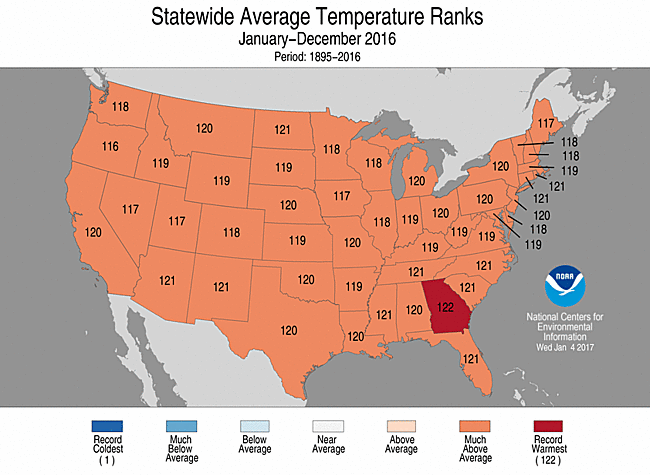2016 was the second-warmest year on record in the U.S.
NOAA
A map depicting average temperatures across the U.S. with orange representing “above average” and red representing “record high.” 2016 was the second warmest year on record in the U.S.
January 16, 2017
2016 was the second warmest year on record for the U.S. and was accompanied by a marked increase in the number of extreme weather disasters, according to the National Oceanic and Atmospheric Association (NOAA).
The average temperature last year was 54.9 degrees Fahrenheit, the second-highest average temperature in 122 years of record-keeping. This is also the 20th consecutive year that the nation’s average temperature has been higher than the average from the 20th century.
Over the past year, the U.S. has also had to face above-average precipitation and fifteen separate weather disasters, including storms, floods, hurricanes, droughts and wildfires.
El Niño, a climate cycle that involves the development of a band of warm ocean water in the central Pacific Ocean, may have contributed to rising temperatures and extreme weather.
“Last year […] was a significant El Niño year, and that leads to fluctuations in global temperatures,” biology teacher and Green Team advisor Kate Schafer said. “It wouldn’t be a shock if 2017, which is a La Niña year, where ocean temperatures are abnormally cool, wasn’t the warmest year on record. However, that doesn’t mean that global warming isn’t happening.”
Leading contributors to rising average temperatures also include the presence of greenhouse gases, which are often produced by human actions such as raising meat for food and using transportation involving fossil fuels.
“The biggest [contributor] that most people don’t realize is meat production,” Green Team secretary Anika Banga (11) said. “Cattle especially releases the greenhouse gas methane instead of carbon dioxide, which stays in the atmosphere for much longer.”
Though the effects of climate change cannot be reversed, reducing one’s carbon footprint through actions such as using renewable energy and opting for electric or solar-powered cars can help mitigate future effects of climate change.
“I feel like [climate change] is just something we’ll have to mitigate, not solve,” said AP Environmental Science teacher and Green Team advisor Jeff Sutton. “Hopefully, renewable energy production is becoming more widespread. A lot of cities in the Bay Area are choosing to use renewable energy, which is amazing.”
Though global data on average temperatures will not be released until Jan. 18, preliminary data released in July by agencies such as NASA show that 2016 is projected to be the warmest year on record globally.


















![“[Building nerf blasters] became this outlet of creativity for me that hasn't been matched by anything else. The process [of] making a build complete to your desire is such a painstakingly difficult process, but I've had to learn from [the skills needed from] soldering to proper painting. There's so many different options for everything, if you think about it, it exists. The best part is [that] if it doesn't exist, you can build it yourself," Ishaan Parate said.](https://harkeraquila.com/wp-content/uploads/2022/08/DSC_8149-900x604.jpg)




![“When I came into high school, I was ready to be a follower. But DECA was a game changer for me. It helped me overcome my fear of public speaking, and it's played such a major role in who I've become today. To be able to successfully lead a chapter of 150 students, an officer team and be one of the upperclassmen I once really admired is something I'm [really] proud of,” Anvitha Tummala ('21) said.](https://harkeraquila.com/wp-content/uploads/2021/07/Screen-Shot-2021-07-25-at-9.50.05-AM-900x594.png)







![“I think getting up in the morning and having a sense of purpose [is exciting]. I think without a certain amount of drive, life is kind of obsolete and mundane, and I think having that every single day is what makes each day unique and kind of makes life exciting,” Neymika Jain (12) said.](https://harkeraquila.com/wp-content/uploads/2017/06/Screen-Shot-2017-06-03-at-4.54.16-PM.png)








![“My slogan is ‘slow feet, don’t eat, and I’m hungry.’ You need to run fast to get where you are–you aren't going to get those championships if you aren't fast,” Angel Cervantes (12) said. “I want to do well in school on my tests and in track and win championships for my team. I live by that, [and] I can do that anywhere: in the classroom or on the field.”](https://harkeraquila.com/wp-content/uploads/2018/06/DSC5146-900x601.jpg)
![“[Volleyball has] taught me how to fall correctly, and another thing it taught is that you don’t have to be the best at something to be good at it. If you just hit the ball in a smart way, then it still scores points and you’re good at it. You could be a background player and still make a much bigger impact on the team than you would think,” Anya Gert (’20) said.](https://harkeraquila.com/wp-content/uploads/2020/06/AnnaGert_JinTuan_HoHPhotoEdited-600x900.jpeg)

![“I'm not nearly there yet, but [my confidence has] definitely been getting better since I was pretty shy and timid coming into Harker my freshman year. I know that there's a lot of people that are really confident in what they do, and I really admire them. Everyone's so driven and that has really pushed me to kind of try to find my own place in high school and be more confident,” Alyssa Huang (’20) said.](https://harkeraquila.com/wp-content/uploads/2020/06/AlyssaHuang_EmilyChen_HoHPhoto-900x749.jpeg)










